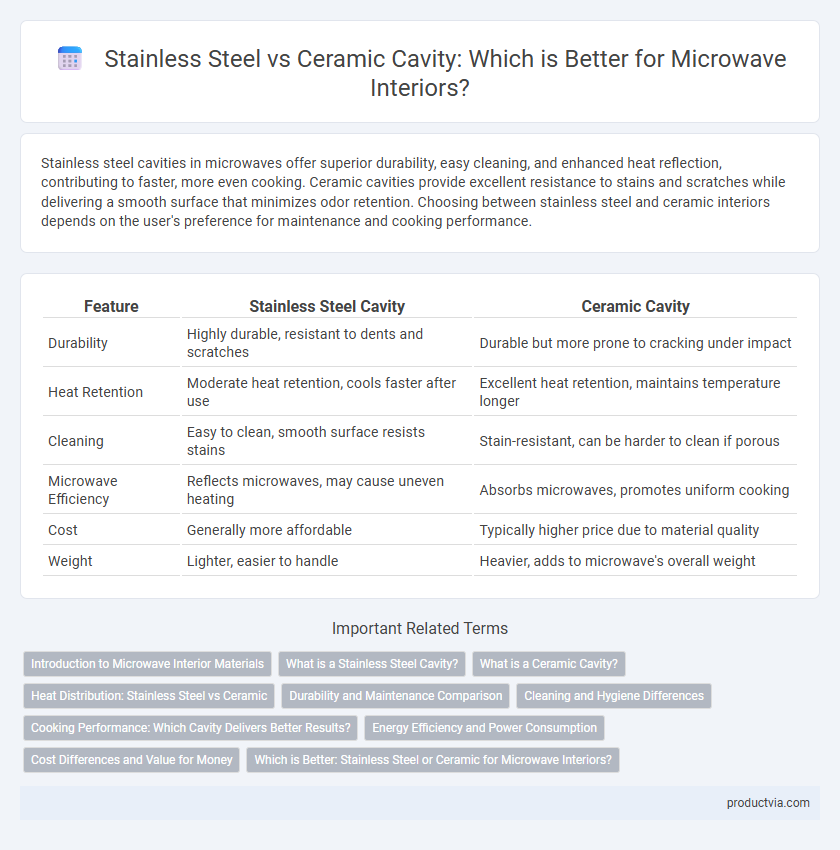Stainless steel cavities in microwaves offer superior durability, easy cleaning, and enhanced heat reflection, contributing to faster, more even cooking. Ceramic cavities provide excellent resistance to stains and scratches while delivering a smooth surface that minimizes odor retention. Choosing between stainless steel and ceramic interiors depends on the user's preference for maintenance and cooking performance.
Table of Comparison
| Feature | Stainless Steel Cavity | Ceramic Cavity |
|---|---|---|
| Durability | Highly durable, resistant to dents and scratches | Durable but more prone to cracking under impact |
| Heat Retention | Moderate heat retention, cools faster after use | Excellent heat retention, maintains temperature longer |
| Cleaning | Easy to clean, smooth surface resists stains | Stain-resistant, can be harder to clean if porous |
| Microwave Efficiency | Reflects microwaves, may cause uneven heating | Absorbs microwaves, promotes uniform cooking |
| Cost | Generally more affordable | Typically higher price due to material quality |
| Weight | Lighter, easier to handle | Heavier, adds to microwave's overall weight |
Introduction to Microwave Interior Materials
Microwave interiors commonly use stainless steel cavities or ceramic cavities, each offering distinct advantages in durability and heat resistance. Stainless steel cavities provide excellent reflectivity and long-lasting strength, enhancing microwave efficiency by evenly distributing microwaves. Ceramic cavities excel in heat retention and resistance to staining, making them ideal for high-temperature cooking and maintaining a clean interior environment.
What is a Stainless Steel Cavity?
A stainless steel cavity in a microwave refers to the interior chamber made from durable, corrosion-resistant stainless steel, enhancing heat reflection for even cooking. This material is favored for its easy-to-clean surface, resistance to stains, and longevity compared to ceramic cavities. Stainless steel cavities also contribute to improved microwave energy distribution, resulting in efficient cooking performance.
What is a Ceramic Cavity?
A ceramic cavity in a microwave oven refers to the interior lining made from durable ceramic enamel that resists scratches, stains, and corrosion. This material enhances heat distribution and maintains cleanliness by preventing food residues from adhering to the surface. Ceramic cavities offer improved durability and easier maintenance compared to traditional stainless steel interiors.
Heat Distribution: Stainless Steel vs Ceramic
Stainless steel cavities in microwaves provide rapid and even heat distribution due to their highly reflective surfaces that bounce microwave energy efficiently throughout the interior. Ceramic cavities absorb and slowly release heat, promoting a more uniform temperature but potentially leading to longer cooking times. Choosing between stainless steel and ceramic cavities affects cooking performance, energy efficiency, and the durability of heat distribution within the microwave oven.
Durability and Maintenance Comparison
Stainless steel cavities in microwaves are highly durable, resistant to rust, and easy to clean with simple wiping, making them low-maintenance and ideal for long-term use. Ceramic cavities offer excellent resistance to scratches and stains, providing a smooth, non-porous surface that prevents food buildup and odors, but they can be more prone to chipping if handled roughly. Both materials enhance microwave longevity, with stainless steel excelling in durability while ceramic provides superior cleanliness and ease of maintenance.
Cleaning and Hygiene Differences
Stainless steel cavity microwaves offer a smooth, non-porous surface that resists stains and food odors, making cleaning easier and more hygienic by preventing bacterial buildup. Ceramic cavity interiors provide excellent resistance to scratches and discoloration but can be more prone to absorbing food particles in microscopic pores, requiring more meticulous cleaning to maintain hygiene. The durable, sleek surface of stainless steel is generally preferred in kitchens prioritizing rapid, effective sanitation and long-term cleanliness.
Cooking Performance: Which Cavity Delivers Better Results?
Stainless steel cavities in microwaves offer superior heat reflection, ensuring even cooking and faster heating times compared to ceramic cavities, which absorb more microwaves and may lead to uneven heat distribution. Ceramic cavities provide better durability and are easier to clean, but their microwave absorption can result in hotspots and longer cooking cycles. For optimal cooking performance, stainless steel interiors are preferred due to enhanced energy efficiency and more uniform food preparation.
Energy Efficiency and Power Consumption
Stainless steel cavities in microwaves offer superior durability and reflect microwaves more effectively, enhancing cooking efficiency and reducing power consumption. Ceramic cavities provide excellent heat retention and uniform temperature distribution, potentially improving energy efficiency during prolonged use. Choosing between these materials impacts microwave performance, with stainless steel favoring quicker, energy-saving cooking cycles and ceramic benefiting consistent heating with stable energy use.
Cost Differences and Value for Money
Stainless steel microwave cavities typically cost more upfront due to durable, corrosion-resistant properties but offer excellent longevity and ease of cleaning, resulting in better long-term value for high-use environments. Ceramic cavities tend to be more affordable initially, providing efficient heat retention and uniform cooking, yet they may chip or stain over time, potentially increasing maintenance or replacement costs. Consumers prioritizing initial expense often choose ceramic, while those seeking durability and low upkeep prefer stainless steel for optimum cost-effectiveness.
Which is Better: Stainless Steel or Ceramic for Microwave Interiors?
Stainless steel cavities in microwaves offer superior durability and superior heat reflection, leading to faster and more even cooking compared to ceramic interiors. Ceramic cavities provide better resistance to staining and are easier to clean, maintaining a sleek appearance over time. For optimal performance and longevity, stainless steel is generally preferred in heavy-use households, while ceramic suits those prioritizing ease of maintenance.
Stainless steel cavity vs Ceramic cavity for microwave interiors Infographic

 productvia.com
productvia.com